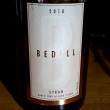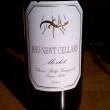2009 Harvest Update: Solving Ripening Mysteries at Ravines Wine Cellars

Ravines Wine Cellars pinot noir being pressed
By Evan Dawson, Finger Lakes Editor
Photos courtesy of Ravines Wine Cellars
Morten Hallgren thinks he might be close to solving one of the viticultural mysteries of the Finger Lakes.
 Hallgren, the owner and winemaker of Ravines Wine Cellars on Keuka Lake, purchases grapes from a handful of prized sites. One of them, Harvest Ridge Vineyards on the east side of Seneca Lake, has seen ripening happen at a very fast pace over the past several vintages. This year is no different; grower Chris Verrill's riesling was showing 20.5 brix when many other vineyards had riesling inching along in the upper teens.
Hallgren, the owner and winemaker of Ravines Wine Cellars on Keuka Lake, purchases grapes from a handful of prized sites. One of them, Harvest Ridge Vineyards on the east side of Seneca Lake, has seen ripening happen at a very fast pace over the past several vintages. This year is no different; grower Chris Verrill's riesling was showing 20.5 brix when many other vineyards had riesling inching along in the upper teens.
But why? Last year I joined Hallgren on a visit to Harvest Ridge Vineyards in early fall. Verrill wanted to pick earlier than Hallgren had anticipated, so the winemaker drove to the other side of the lake with the intention of instructing Verrill to hold off. He was shocked — as was I — to see pinot at 24 brix and other varieties well ahead of surrounding sites.
"I've become convinced that the Lyre trellis system at Chris Verrill's vineyard is making a huge impact," Hallgren says. "Ripening happens very nicely on this system, and there is much more exposure to sunlight." (For an interesting research article on Lyre and other trellis systems, click here).
But Hallgren points to another significant factor: croploads, which are carefully monitored not only at Harvest Ridge, but his other sites as well. The pinot noir from Harvest Ridge came in at 1.9 tons per acre.
"I understand why people are worried about cabernet franc this year, but so much will come down to cropping." he says. "Our cabernet franc that will come from Argetsinger Vineyard (on Seneca Lake) is a great example. Many growers can't get it to ripen this year. But if you see cabernet franc at sites like Sam Argetsinger's, the difference is remarkable."
Hallgren expects to bring in the Argetsinger Vineyard Riesling — which he bottles in a single-vineyard edition — late this week. He'll wait for other red varieties such as cabernet franc and lemberger until later this month or even longer. For this Danish-born and French-trained winemaker, vineyard site is the most important component to great winemaking.
"Without strong vineyards and the right practices, you might not have a chance. And when the 2009 wines become available you'll really be able to see the difference between good vineyard sites and bad vineyard sites. You'll see the difference between good vineyard practices and bad vineyard practices."
More than most years, Hallgren is thankful to have discovered some of the most talented growers in the region.

















Does the Lyre system have added expenses or any drawbacks under certain conditions?
Funny, when a bunch of us were in Burgundy 10 years ago, we went to the viticultural research station and noticed that they were growing their clone trials with a lyre trellis. When I asked them why, they said “Because it gives us the best quality fruit.” Me: “Then why don’t any producers in Burgundy use a lyre trellis?” Them: “Because it’s against the law!”
Gotta love the French.
Peter, that has got to be the funniest thing I’ve read on this blog in some time.
Are you guys using Lyre at all at Fox Run? If not, why not?!?!
To Jason’s questions, what are the drawbacks and tradeoffs?
Lenn/Evan/Jason - you guys are almost asking for a thesis on canopy management, but here goes a very shortened answer:
Yes, the lyre system can be more expensive for at least a couple of reasons: 1) it uses more wire and metal supports, and therefore costs more to establish, and 2) it can cost more to prune and harvest than a VSP system because you have more shoots, canes, etc., and I don’t know of anybody who can harvest a lyre trellis in the Finger Lakes mechanically.
The lyre system is a divided canopy system, which is designed for vineyard sites with higher vigor. It allows for more buds to be retained per vine and allow the shoots from those buds to be spread out over a larger “surface area”. It all comes back to research by Dr. Nelson Shaulis at Cornell many years ago, who developed the Geneva Double Curtain trellis (originally for Concord vineyards) to increase the amount of exposed leaf area per unit of fruit on the vine (the always elusive concept of “vine balance”). This work has been expanded upon by a whole host of viticulturists around the world to develop other training systems, including the lyre. But study after study has shown that, in the right situation, divided canopy systems can improve productivity without sacrificing fruit quality - even improving it in some circumstances.
Hans, your summary is informative in scope and impressive in its brevity. Thanks for spelling it all out!
A great piece of information. I simply loved your post. Thank you so much for the information. And in addition to yours, I would like to share a well packaged breed of cigars. They are called Cohiba Cigars. Try these out as well.
Also, I am adding your website to my bookmarks!
It’s great!